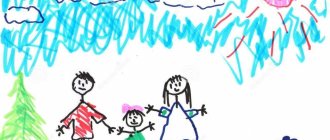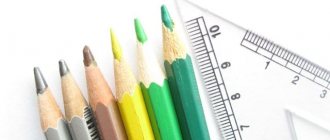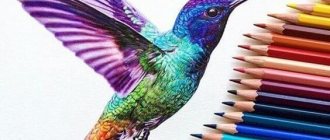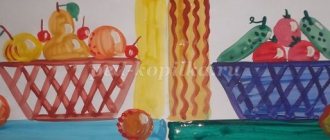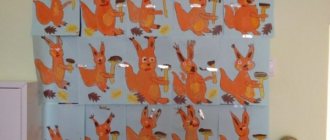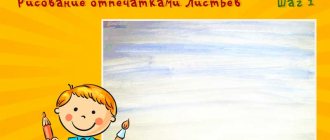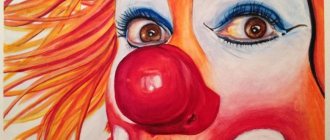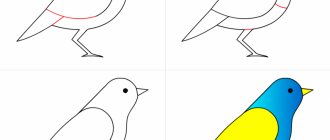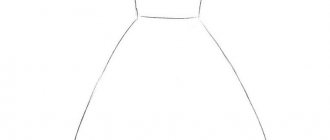How to draw a dandelion with paints step by step for children
Master class on drawing for children 4-6 years old “Dandelion”
Author: Victoria Aleksandrovna Ostanina, teacher of the Children's Preschool Educational Institution DS KV "Rainbow" JV "Silver Hoof" Purpose: Performing a drawing using an unconventional technique. Objectives: - get acquainted with an unconventional drawing technique - the “poke” method; — develop creative abilities; — learn to be careful when working with gouache. Purpose: This master class will be useful for educators, additional education teachers, and primary school teachers. It can also be used by creative people and parents who independently study with their children. Description: The master class gives you the opportunity to draw a flower yourself - a dandelion. Does not require special artistic skills. A detailed description and step-by-step photos will make the drawing process easy and effective. Materials: A4 sheet, gouache, water glass, cotton napkin, brush No. 5 bristles, brushes No. 3, No. 5 (goat, squirrel).
Progress: Summer! Summer! Summer is around! So many bright colors, fragrant herbs and colorful flowers. The beauty of the Ural nature is simply mesmerizing! Sineva cornflowers,
sunny beauty of dandelions,
delicate white daisies!!!
How many fragrant herbs, crackling grasshoppers and humming dragonflies... Today we will draw.... A riddle will tell us what we draw! “In childhood, with a yellow head, In youth, completely gray-haired, But he never gets old, He flies away in white fluff!” (E. Telushkina) Of course it’s a dandelion! He's so handsome!
Dandelion is familiar to us as a small sun and white fluff.
And if you blow on it, it will fly apart.
And its seeds scatter far around. You and I will draw a dandelion like this:
Or maybe not exactly like that, let’s add some white dandelions! For work we need a white sheet of paper, gouache, three brushes: ordinary squirrel brushes No. 3 and No. 6, and hard bristles No. 5, a glass of water and a cloth napkin.
We will draw the stem and leaves in the usual, familiar way. But the flowers are made using an unconventional method - the “poke” method. This method is used for drawing furry animals, flowers, images of snow, fireworks. It is unusual in that before starting to paint you should not dip the brush in water; this is a dry method of painting. We immediately dip a dry brush into gouache, it is most suitable, but we must remember that the gouache should be thick and not dry. You only need to dip the tip of the brush into the gouache. We hold the brush strictly vertically, apply the design by applying the brush to the sheet, as if “poking” into it. Hence the name - the “poke” method. We make the first “poke” on an additional sheet so that subsequent “poke”s are of a uniform color. The space designated for the flower should be filled evenly, placing the “pokes” close to each other, trying not to leave gaps and without overlapping them. And one more little secret: the end of the brush needs to be trimmed a little so that it is flat, not rounded or sharp, but straight. Then the “poke” will be fluffier. I suggest trying it on an additional sheet, making a few pokes, filling out an imaginary form. Have you tried it? Then go ahead! Towards creativity! Progress:
1. Let's make the background. We need brush No. 5, blue gouache, water. Wet the sheet with water using a brush and apply the color evenly. We try to leave the edge of the sheet white on all sides - this will be the frame.
Let the sheet dry. The background is ready. 2. Place the sheet vertically. With brush No. 3 we draw the stems.
3. Now the leaves. First we draw the outline.
Now let's fill it with color.
4. Now we will draw a yellow dandelion. We need a bristle brush and yellow gouache. Don’t forget the features of the “poke” method and start drawing a flower. Remember, the brush is positioned strictly vertically in relation to the sheet! And “poke”, “poke”, “poke”!
Here is our living sun!
5. Draw a fluffy dandelion with white gouache.
And another fluffy one.
Let's decorate the leaves with a thin brush along the contour. The work is ready!
You can draw other versions of the dandelion.
This is how they look together.
And here is a field of dandelions.
My kids immediately noticed these works on the wall in the group and wanted to draw too! I want to present you the best work! It was performed by Ekaterina Ermakova. She is only five years old, but she did her job completely on her own! This is her dandelion!!!
We created a mini-exhibition in the group!
Beautiful? Join us! Create like us, do better than us!
We recommend watching:
Hand drawing for children 3-7 years old. Dandelions How to draw lilies of the valley with gouache step by step Drawing for children 8-10 years old. Bouquet of daisies step by step with photos Master class on drawing for children 5-7 years old “Fairytale flowers in a lace frame” step by step with photos
Similar articles:
Drawing lesson for children 6-7 years old. Drawing Dandelions
Drawing dandelions in the preparatory group
Step-by-step instructions for drawing a dandelion with a pencil
The dandelion (the drawing for children over 10 years old should be detailed) should be drawn with sharply sharpened pencils so that the lines are thin and graceful. The picture shows 2 stages of flower development at once: a bud and an inflorescence with seeds. You also need to draw a plant leaf with large teeth.
Sketch
Drawing should begin by marking the contours of the flower. For this you need a hard pencil.
Procedure:
- Draw 1 vertical line from the center of the sheet from bottom to top. It should not be straight, as if drawn with a ruler. On the contrary, you need to make it smooth, slightly curving. This is the base of the dandelion stem. These flowers do not grow straight. Their stems bend from the weight of the inflorescences and take on a curved shape.
- Draw 1 more line nearby. This will be the 2nd stem for another inflorescence. It can be drawn shorter or longer than the first one. It is important that the stems at the bottom come out from 1 point, and at the top they diverge in different directions. The distance between their pinwheels should be such that the flowers drawn next do not intersect with each other.
- Draw a 3rd line on the opposite side. It should be a little shorter than the previous 2. Its top needs to be taken away from others.
- The last line drawn is the middle of the dandelion leaf. Now you need to give it a shape, marking wide teeth on both sides, as well as a sharp top.
- Above 1 line indicate the shape of a fluffy hat with seeds. This should be done with thin, intermittent strokes.
- Above the 2nd line draw the shape of an unopened bud.
A sketch helps to maintain the correct proportions and correctly position all the small details in the drawing. When creating a sketch, you should not put pressure on the pencil. The lead should barely touch the paper and leave almost imperceptible marks.
When all the details are drawn in the picture, the lines made with a hard pencil will need to be erased. If the sketch is rich and clear, it will be difficult to remove it. The result will be a messy drawing.
Detailing
All details must be drawn with a hard-soft pencil.
Procedure:
- Next to each line that imitates the shape of the stem, you need to draw 1 more parallel line. It is important that it follows all the curves. The distance between these lines should be small. They are needed to make the flower stem voluminous.
- Draw sepals on the tops of the stems. They don't have to be straight either. Let the petals bend and twist in different directions. There should be 3-4 petals on 1 sepal.
- Where the shape of the bud is indicated, you need to draw folded leaves, and at the top the protruding ends of the petals.
- There will be a cap with seeds above the 2nd stem, so first you need to draw the core of the flower. It is oval in shape and protrudes above the surface of the sepals.
- Now from this core you need to draw many small lines of different sizes. They should stick out in different directions.
- Using a hard pencil, draw fluff to the top of each line.
- Above the fluffy hat you can depict flying seeds that have calved from the flower. First, draw a line, add fluff on top, and draw an elongated seed below using a soft pencil. The seeds should fly in different directions.
- Draw veins on the leaf of the flower.
The connection of the stems below can be covered with painted grass. Remove all extra lines with an eraser.
Hatching
To make the drawing look three-dimensional, you need to depict shadows. They are applied with strokes using a soft pencil.
Procedure:
- Shade the area under the flower.
- Apply horizontal strokes to 1 side of the stem.
- Mark the shadow under the sepals.
- Darken the middle of the sheet.
Gently rub all the strokes with your fingers. To shade the pencil inside the stem, you can use a cotton swab.
